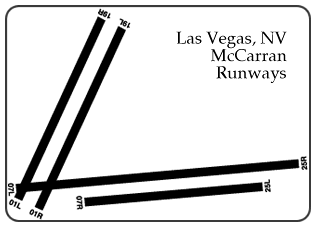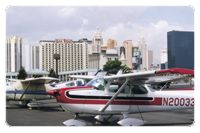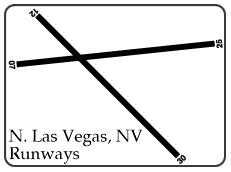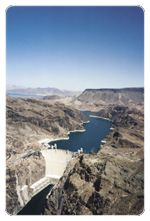 Las Vegas is an oasis. Not just the obvious glass, concrete and neon island situated in a sea of sun-baked sand and unforgiving rock, but more figuratively, a break in the endless dunes of the daily routine. Such isolation has helped to spur the character of this aviation-friendly city. Nowhere but in Las Vegas can you travel on foot from a giant pyramid guarded by a looming sphinx to the canals of Venice and on to a pirate's cove in a matter of minutes. And only in Las Vegas can you stumble over a toddler running from his frantic mother as you graciously accept free drinks from a scantily clad hostess while on your way to cash in handfuls of plastic chips. Las Vegas is an oasis. Not just the obvious glass, concrete and neon island situated in a sea of sun-baked sand and unforgiving rock, but more figuratively, a break in the endless dunes of the daily routine. Such isolation has helped to spur the character of this aviation-friendly city. Nowhere but in Las Vegas can you travel on foot from a giant pyramid guarded by a looming sphinx to the canals of Venice and on to a pirate's cove in a matter of minutes. And only in Las Vegas can you stumble over a toddler running from his frantic mother as you graciously accept free drinks from a scantily clad hostess while on your way to cash in handfuls of plastic chips.
The same isolation that helped to create the unique atmosphere of this desert city has necessitated an attitude towards aviation that many other cities lack. From the days when a private pilot could land on the golf course at the Desert Inn to the modern runways of McCarran International Airport (LAS)—with general aviation facilities located mere minutes from the action—Las Vegas has continued to offer pilots a relaxing, easy-to-fly-into destination. The simplicity of flying in Las Vegas' Class B airspace, when combined with the dramatic scenery surrounding the city, allows you to start your vacation while still in the air.
The traditional and obvious attraction of Las Vegas is the strip. And what better way to enjoy this two-and-a-half mile row of casinos, amusement parks and themed attractions than to fly in and park your plane in the shadow of these mega-hotels. McCarran International Airport offers you this opportunity. The airport is accustomed to transient GA fly-in traffic and has set up its standard traffic flow to make your arrival as easy as losing a paycheck at the craps table.

The preferred runways are 19 and 25, helping to keep the heavies and GA traffic separated. Runways 19 L/R are used for general aviation traffic, with arrivals using 19R, and GA departures from 19L. Air carriers arrive on 25R. This arrangement also simplifies the entry procedures through the class B, with all light aircraft traffic being directed north of the field.
Negotiating the Las Vegas class B airspace to land at McCarran is quite straightforward, especially if you have spent some time studying a current Las Vegas VFR Terminal Area Chart. The best arrival routes are from the east and west, affording you and your passengers great views of Downtown and the Strip.
When approaching the Class B from the northeastern athrough southeastern quadrants, expect instructions to fly east and south of Frenchman Mountain below 5,000 feet to enter on base leg for runway 19R.
Approaching from the west you will likely be instructed to follow Charleston Blvd. at 4,000 feet for a right base to 19R. (Charleston is the highway depicted on the VFR chart leading into town from the high terrain due west of Las Vegas, and runs just south of the North Las Vegas Class D and the Stratosphere Tower.)
 Arrivals from the south and southwest are normally instructed to fly along the east side of Interstate 15 to cross over Henderson Airport, then north to overfly the approach end of runway 25R at or above 4000 feet followed by a quick descent to final. While this southerly arrival is not necessarily difficult, it may not be the most enjoyable approach for you or your passengers. As an alternative, try staying outside and below the Class B airspace to the east. This route will take you over Hoover Dam and Lake Mead, offering a great sightseeing trip on your way in. (Watch out for the very heavy commercial sightseeing traffic in this area. As a precaution, consider monitoring 120.65 for plane to plane communications from Las Vegas across the Hoover Dam to the Grand Canyon SFRA.) Arrivals from the south and southwest are normally instructed to fly along the east side of Interstate 15 to cross over Henderson Airport, then north to overfly the approach end of runway 25R at or above 4000 feet followed by a quick descent to final. While this southerly arrival is not necessarily difficult, it may not be the most enjoyable approach for you or your passengers. As an alternative, try staying outside and below the Class B airspace to the east. This route will take you over Hoover Dam and Lake Mead, offering a great sightseeing trip on your way in. (Watch out for the very heavy commercial sightseeing traffic in this area. As a precaution, consider monitoring 120.65 for plane to plane communications from Las Vegas across the Hoover Dam to the Grand Canyon SFRA.)
Once on the ground at McCarran, the two FBOs on the field will do their best to make your life easy. Both are located just west of runway 19; Eagle Las Vegas Executive Terminal is located at the approach end and Signature Flight Support is at the departure end. Parking at either of these establishments gives you immediate access to the strip. Though they are located close enough to be within walking distance of many of the more popular casinos on the strip, courtesy shuttles and rental cars are available from both FBOs. In addition, either FBO will help with hotel and entertainment arrangements—as well as more elegant ground transportation.
As with everything else here in Las Vegas, convenience and service carry a price. Fuel costs start at $2.85/gallon for 100LL and $2.40/gallon for Jet A, and tie down fees (which are generally waived for at least the first night if fuel is purchased) start at $15 for a single and exceed $50 for jets. If cost is a great concern, see the sidebar featuring reliever airports.
On a recent trip to Las Vegas, I was fortunate enough to park at Eagle Las Vegas Executive Air Terminal. The service and atmosphere at Eagle Las Vegas were exceptional; a van was waiting before the plane was shut down, and the counter staff proved to be very friendly and efficient. In my experience, regardless of whether you arrive in a Gulfstream or a Cessna 150, they'll show appreciation for your business. Ramp space at Eagle is somewhat limited and can fill up on holiday weekends or during big conventions. Radio ahead on ARINC 128.85 prior to entering the Class B for current status.
Signature Flight Support (128.87) also prides itself on customer service, offering full concierge service and a much larger ramp. I was, however, put-off by the rather vague handling fee Signature imposes: a tariff of $20 to $340 which may be waived if the plane is topped off. Because I could not get a definite answer on whether or not the fee would be waived, I parked at Eagle where the fee is not a concern (Eagles tie down fees are slightly higher though.). Web savvy pilots can find more information about both FBOs and McCarran International at www.airnav.com.
So, now you're in Las Vegas. What next? Well, that all depends on your idea of fun. There are really two Las Vegases (Or is it Las Vegi?). One has been portrayed in so many songs and old movies, with its danger and temptation and lure of the forbidden: Sin City. The other is the new Las Vegas: more like Disneyland with slot machines and strippers than the city the Rat Pack made their honorary clubhouse. Many of the old casinos have been replaced with themed attractions, delicately balancing the adult appeal of gambling, liquor and sexuality with the amusement park excitement of rides, games and entertainment fit for an extravagant church picnic.
If the traditional idea of gambling and showgirls is your desire, just walk into any one of the endless number of casinos and you're set. If you prefer more variety, Las Vegas has plenty to offer you, and the strip is the best place to start. The resort style hotels that line Las Vegas Blvd. are the main attractions in the city. And with each new one trying to outdo the last, they have definitely gone over the top.
When you enter one of these themed attractions, time becomes meaningless. From the ringing of the slot machines and flashing lights to the live music and lion shows, the 24-hour-a-day lifestyle within each of the fantasy worlds is filled with perpetual excitement. Ride a roller coaster at New York, New York. Let your body be hurled towards space at Stratosphere or free fall to earth at the MGM Grand. Visit a three ring circus at Circus, Circus. Climb the Eiffel Tower at the soon-to-be open Paris. Witness the Cirque du Soleil show Mystere at Treasure Island or synchronized swimmers at Bellagio. The choices of things to do and see are almost endless along the strip, with new attractions opening every season.
For a taste of something different—and ultimately more traditional Vegas—try visiting the Downtown area. This neon cacophony is where it all started, and Fremont Street is still home to some of the few remaining casinos of this bygone time, like the Golden Nugget and Lady Luck. Modern Fremont Street's covered, mall-like atmosphere and nightly light show is definitely a new twist on the old Las Vegas, but the 99 cent shrimp cocktails, topless dancers, and penny slots hearken back to a different time.

Further north, just minutes from North Las Vegas Airport, a new strip has begun to sprout up. With huge parking areas surrounding massive stucco buildings covered by neon and themed fetishes, hotel/casinos like Texas and Fiesta have given an almost urban mall-like feel to an old tradition. Once inside, however, it's all Las Vegas: flashing lights, cheering onlookers at the craps table, free alcohol, and, of course, toddlers to trip over.
You can read visitor ratings and comments on these, and all other Las Vegas area hotels/casinos at www.lvol.com/hotelnks.html. This web page also contains links to each hotels web sites, as well as visitors reviews of Las Vegas shows and restaurants. Another excellent internet site for insider information is the Las Vegas Hack Attack (www.lasvegastaxi.com).
Unless you're one of the lucky winners, you may find that the most difficult thing about leaving Las Vegas is saying goodbye to the money you've lost. Departing the Las Vegas Class B is just as easy as arriving; expect taxi clearance to runway 19L for departure. Be alert for wake turbulence if commercial traffic is using 25, since both runways intersect at the departure ends. If requested, ATC will normally grant a slight left turn immediately after takeoff to help keep you behind and above the path of departing heavy traffic. Expect initial climb clearance to 3500 feet, with higher altitudes granted two minutes after takeoff.
 As your flight takes you away from Las Vegas, you will find yourself alone over the vast, uninhabited desert that surrounds the city. Take a moment to look back at the surreal, glittering island of Las Vegas in this wilderness, and reflect on your experiences there before heading back to the real world. With all of the excitement, entertainment and over the top extravagances, it's easy to get caught up in the fantasy that is Las Vegas. After all, it was created as an escape, a refuge from the stresses and concerns of life—truly, an oasis. As your flight takes you away from Las Vegas, you will find yourself alone over the vast, uninhabited desert that surrounds the city. Take a moment to look back at the surreal, glittering island of Las Vegas in this wilderness, and reflect on your experiences there before heading back to the real world. With all of the excitement, entertainment and over the top extravagances, it's easy to get caught up in the fantasy that is Las Vegas. After all, it was created as an escape, a refuge from the stresses and concerns of life—truly, an oasis.
|

